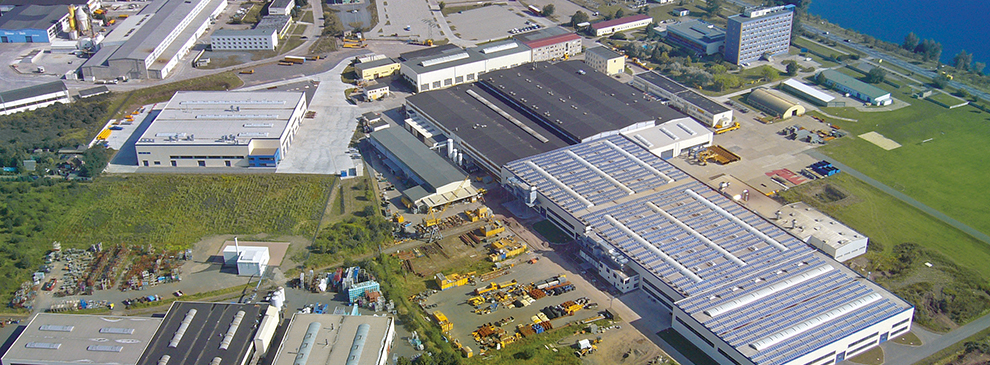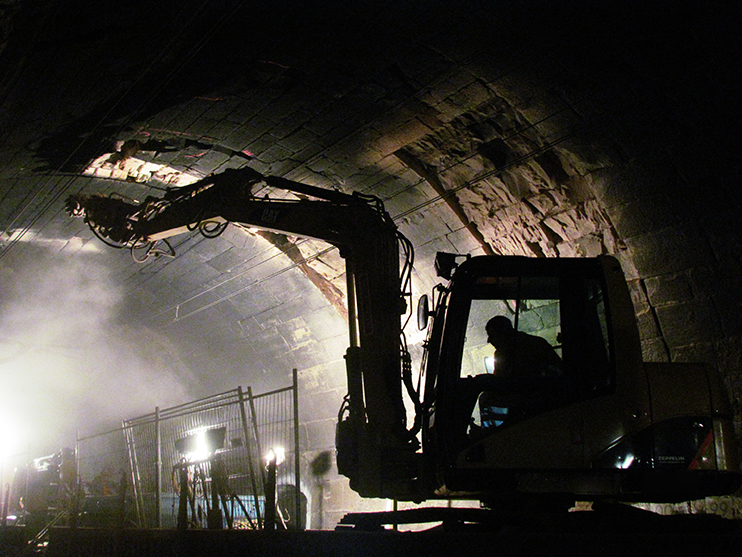Maintenance of Kriegsberg tunnel
Rail line 4860 Stuttgart-Horb, km 4.484 - 5.063
The 579 m long Kriegsberg tunnel is located on the rail line of Stuttgart – Horb, in the built-up area of the city of Stuttgart. The double-tracked, electrified tunnel was driven by miners from 1875 to 1876 and lined with layered masonry of Keuper sandstone. In the time following, the vault divided into 104 zones was maintained several times and section by section. At that, the existing sandstone masonry was replaced locally with clinker masonry or using shotcrete and maintained partially with the TH-arches lying behind. Tunnel longitudinal dewatering runs to the left and right in front of both abutments and trails the tunnel gradient to the east. For the vault drainage, infiltration ditches were partially assembled in the sections maintained with shotcrete. Due to the clearance problems, SCHACHTBAU NORDHAUSEN LLC was commissioned by the DB Netz AG in early summer 2011 to eliminate the bottlenecks detected in the tunnel. As part of these actions, damaged development areas and niches had to be repaired, and infiltration ditches for drainage had to be installed as well as parts of the dewatering had to be maintained. To ensure a widely uninterrupted tunnel traffic, the works were carried out during night lockdown from Monday to Sunday in the period of 25.Jul. and 05.Oct. The works were basically carried out from a work train comprising of AZ-Locomotive and three K-wagons on which the needed devices and equipment such as material container, compressor, electricity aggregate, dumpster, shotcrete machines, etc. were positioned storage safe. Depending on the work to be executed, the work train was equipped additionally with a lifting platform or hydraulic excavator at the construction site facility at Korntal station 13 km away. For the actual works in the tunnel, first, only one track per shift was available for two hours under continuous operation on the neighboring track, and later on, both tracks were available for full closure for 6 hours each. This set high logistical requirements for the workforces to upgrade on-site, to execute the works, and to report the road clear again on time. In the first construction phase, the works carried out were solving the existing bottlenecks and breaking off the damaged development areas. In favor of less vibrating or rock-gently excavation, first, the profile of the area to be broken off was incised by using of a hydraulic joint cutter. Thereafter, the complete area was subdivided into fins through vertical cuts to 10 cm in depth. The cut gap had to be smaller or maximum the depth of excavation and basically needed to be agreed with the condition of masonries or shotcretes. Subsequently, each fin was excavated using a scrapping excavator or by hand using a pick hammer. Masonry areas, where rockfall danger existed, were immediately secured with reinforcement mat and connection anchor BSt500S to ensure a safe rail operation. At the same time, the installation of infiltration ditches was started. For this purpose, the excavation contour in the area of Ulme/Firste had to be cut first up to a depth of 15 cm and a distance of around 25 cm. In the second work step, the actual drainage slot was made by producing two saw-cuts at a distance up to 10 cm and then gently breaking off the remaining ribs. In order to ensure the drainage-effect up to behind the masonry development, each infiltration ditch into the drainage slots three holes Ø 38 mm were drilled up to the bedrock. A coconut-coated drainage pipe was fixed in the drainage slot be means of ribbed expanded metal and connection anchors BSt500S, and connected to the existing tunnel longitudinal dewatering. In the second construction phase, shotcrete works and the area by area repair of the existing masonry were carried out. In all break off areas, reinforcement mats, connection anchors, and subsequently shotcrete C35/45 were installed if this has not been done in the first construction phase. The infiltration ditches were through the installation of shotcrete accomplished as well. Special attention had to be paid for ensuring the application of shotcrete did not create any new clearance restrictions. Finally, each masonry area was renovated by cleaning with high-pressure water jet, repointing and subsequent injection via packers. During these works, the complete catenary system in respective working area had to be protected against pollution or damage. On that point, the track cable of both catenary system was wrapped and fixed with cable protection tubes before the work began as were the hangers up to the isolator. The isolators were rubbed additionally with a silicone paste to prevent shotcrete parts and dust from adhering. Track ballast or concrete floor had to be protected by covering with geovlies against pollution or damage. Parallel to the maintenance of tunnel vault, the whole tunnel longitudinal dewatering was checked on an undisturbed water procedure and maintained if necessary.
Project information
Client:
Deutsche Bahn Netz AG
Schwarzwaldstraße 86
76137 Karlsruhe
Planning and construction supervision:
gbm company for construction geology and
measurement engineering mbH building site
Pforzheimer Straße 126a
76275 Ettlingen
Project Manager:
Dipl.-Ing. Roland Adelt
Execution:
July 2011 - October 2011
Contract value:
369.000,- €
Performance:
Breaking off bottlenecks 100 m²
Breaking off masonry 55 m³
Shotcrete consumption 55 m³
Masonry maintainence 205 m²
Grouting cement 2,5 t
Installation infiltration ditches 50 m
How to find us
SCHACHTBAU NORDHAUSEN GmbH
Industrieweg 2a
99734 Nordhausen
Telephone: +49 3631 632-0
Fax: +49 3631 632-334
E-Mail: sbn@schachtbau.de
Web: www.schachtbau.de
Copyright © , All Rights Reserved

 German
German







